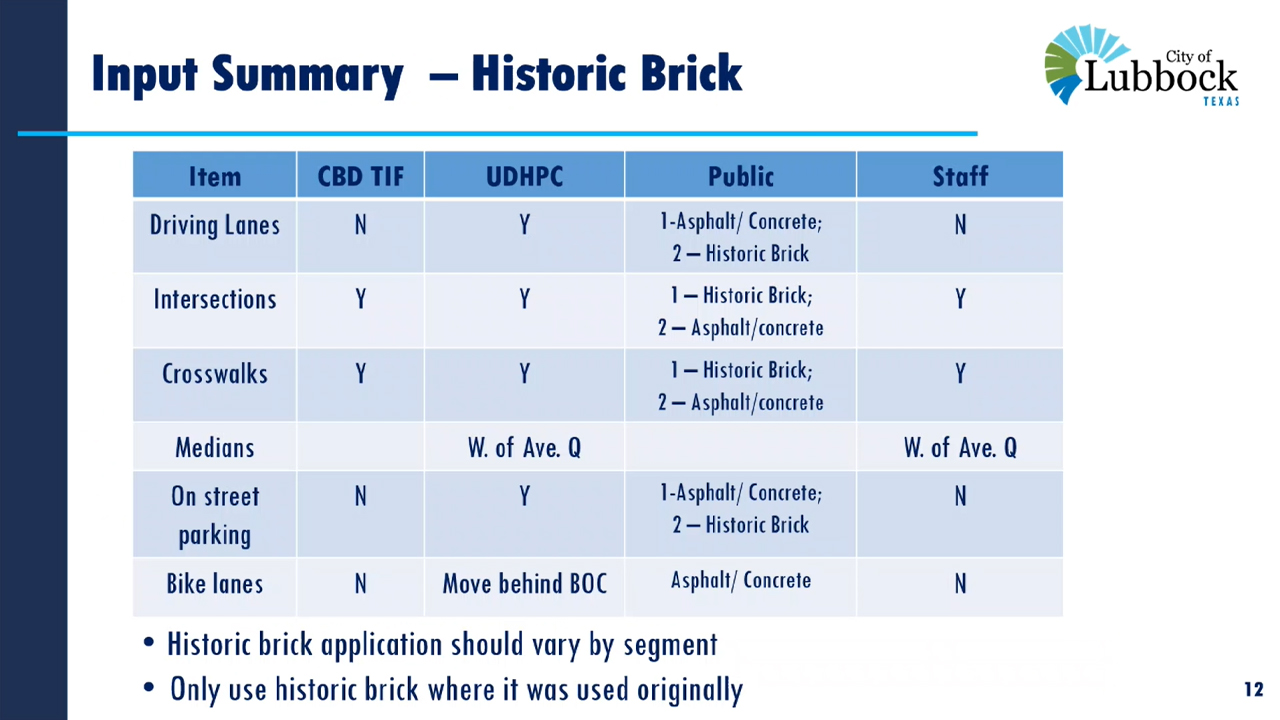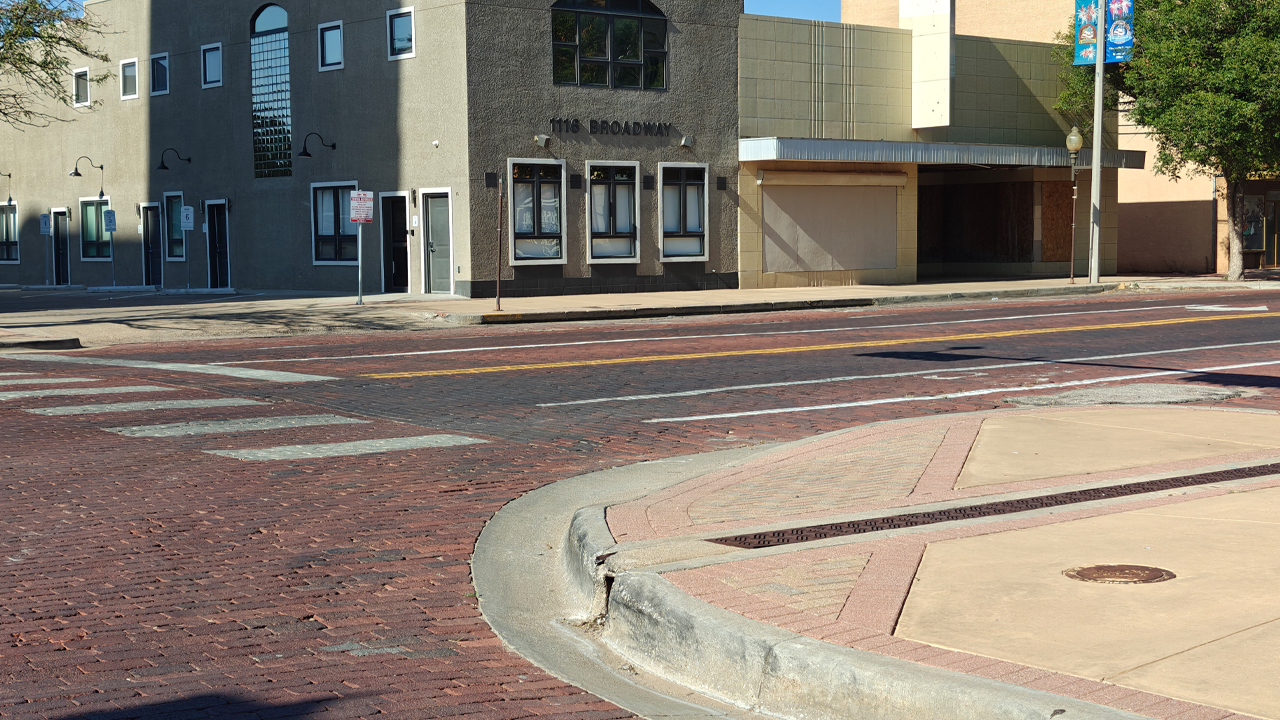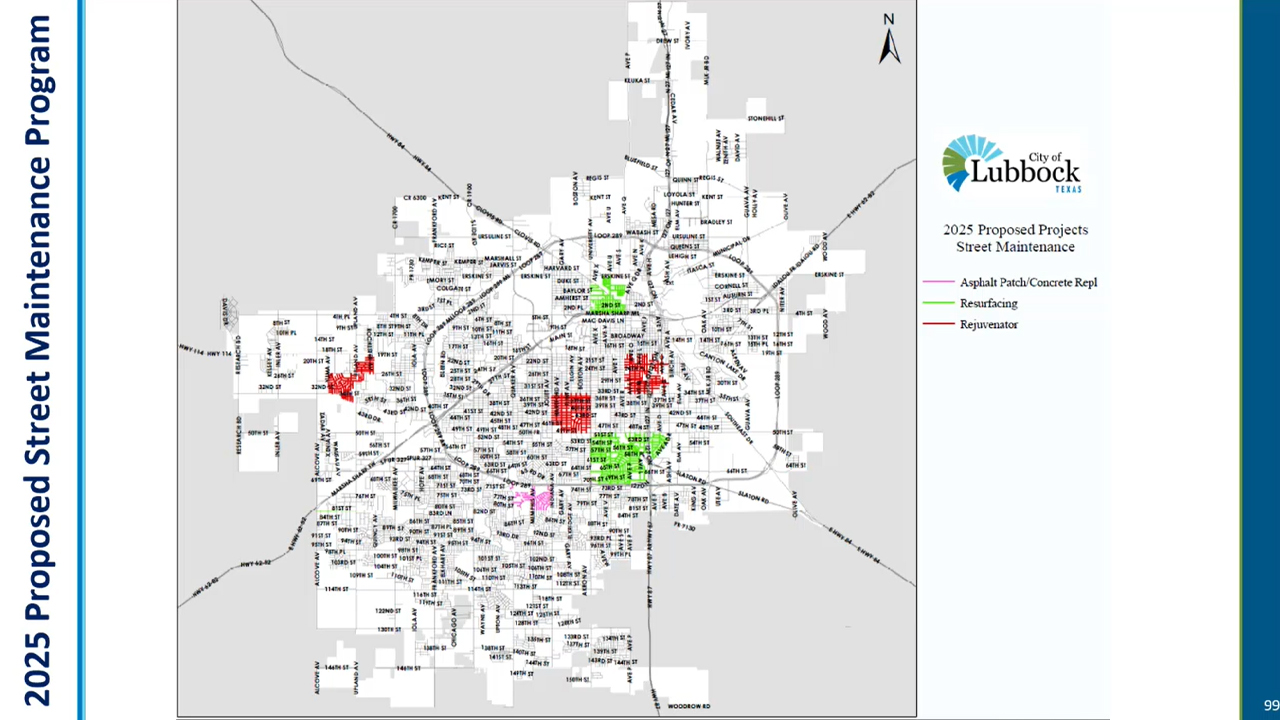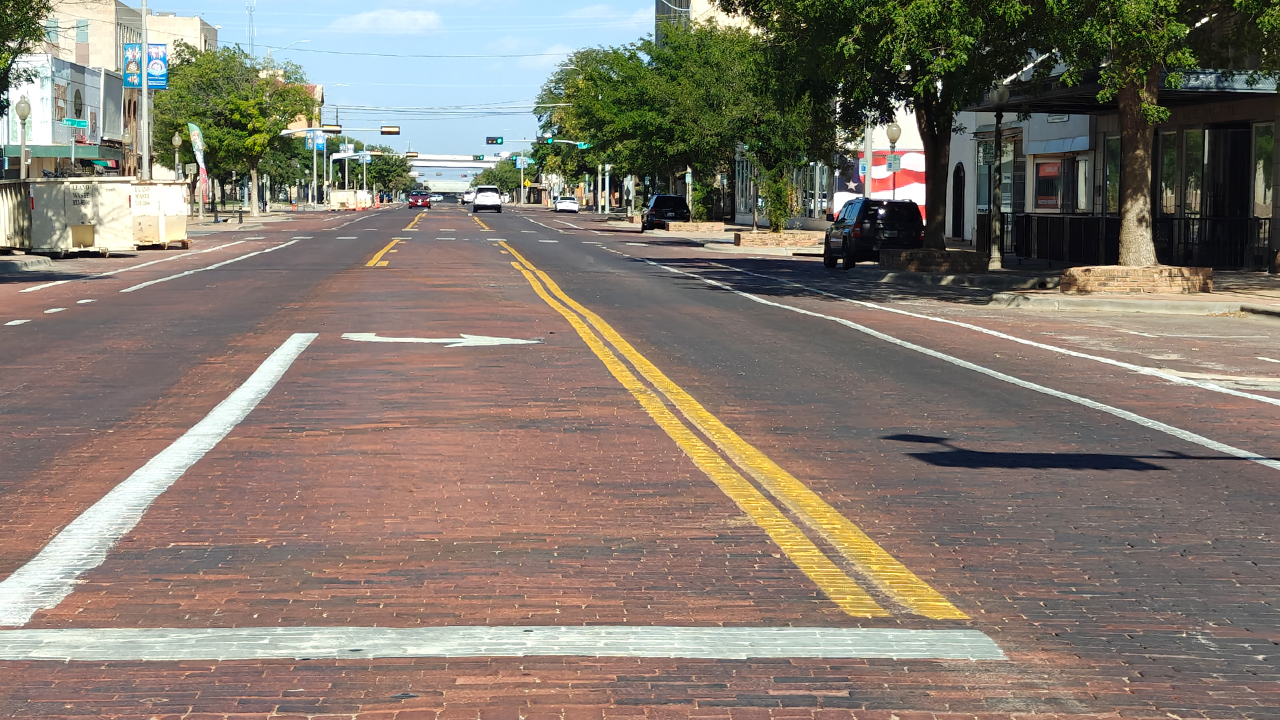Broadway at Avenue K
Five people spoke against $100 million for a proposed road bond during the Lubbock City Council meeting Wednesday afternoon – all because of historic bricks streets.
When Lubbock changed its entire system of zoning ordinances last year, legal protections for the bricks were removed in an “oversight.”
At issue is a stretch of Broadway from Avenue Q to Avenue E – a $16 million project nearly everyone agrees needs to be done. A committee recommends replacing bricks with concrete drive lanes and modern brick pavers at the intersections and crosswalks to hold down the cost.
Keeping everything – drive lanes and all – in historic brick might not even be possible regardless of cost. The city has bricks in storage – most of which are 100 years old or close.
“It would raid our historic brick stockpile to the point where it made a lot of people uncomfortable,” said Heather Keister, chair of the Citizens Advisory Committee which gave the Council a list of projects for voters to decide in a November election.
Then, there’s the money.
Keeping historic bricks just at the intersections brings up the cost to $19 million.
“This segment of Broadway, full brick, would be $48 million — $48 million for Avenue Q to Avenue E,” Keister said to the Council during her presentation Wednesday.
The Council also heard about the committee’s full list of recommendations for the bond and discussed a list of street maintenance priorities.
‘All that exists in those bricks’
Cindy Martin, who spoke during the public comment period, said there’s a reason folks are willing to come back downtown. (The taxable value of downtown tripled in recent years, it was revealed during three days of budget discussions at Citizens Tower.)
“It’s the historic character of downtown! That’s the draw. And the red brick streets, particularly on Broadway, are essential to that character,” Martin said.
But Lubbock only has so much history in the first place, she said.
“Lubbock isn’t blessed with blocks and blocks of landmark historic buildings. … Maintain this historic brick street on Broadway,” Martin said.
Stephen Faulk, a longtime architect in Lubbock, also spoke in the public comment period.
“Someone’s going to get up here in a while and tell you the historic brick is not worth a darn. I disagree completely. I’ve been at this profession for … 53 years. I’ve put down hundreds of thousands of square feet of paving of asphalt, concrete and brick,” Faulk said.
Fauk owns property along Broadway. He said bricks lasted 100 years on Broadway, but then compare that to more recent projects in concrete or asphalt.
“I encourage you to look at University Avenue from 19th to Broadway. It’s cracked. It’s patched,” Faulk said.
Mayor Mark McBrayer talked to LubbockLights.com after the meeting.
“What we have is all that exists in those bricks. … That place, people drive through Thurber on the way to Dallas, it doesn’t exist anymore,” McBrayer said.
Thurber History
The Thurber Brick Plant in Thurber, Texas started in 1897 and closed in 1931 during the Great Depression, according to a 1995 historical marker. It employed 800 men, the marker said, and their bricks paved Old Bankhead Highway, Congress Avenue in Austin and Camp Bowie Boulevard in Fort Worth.

“We can’t go back and do everything in those bricks. Period. That’s just not even a consideration,” McBrayer said.
Removing bricks – just temporarily to fix the street – breaks some of them.
“We lose – I’ve heard different figures but – at least 20 percent of them,” McBrayer said. “We could never go back and re-lay the street with the Thurber Bricks. So, anything we do has to consider a more limited use of the Thurber bricks or the historic bricks.”
Keister mentioned a stockpile of historic bricks. Back in 1982, the city purchased 375,000 Thurber Bricks from Crosbyton and Plainview.
“The cost was a big consideration. The lifespan of material and then our ability to meet other glaring needs was the other piece of the equation,” Keister told the Council.
The historic Thurber Bricks lasted 100 years. Would they last 100 more?
McBrayer added, “We don’t have enough money to do it, nor do we have enough bricks.”

More analysis of the bricks
Keister’s committee considered a public survey from 2023 as well as the concerns of the Central Business District Tax Increment Financing Reinvestment Zone and the Urban Design and Historic Preservation Committee.
“Believe it or not, there is some agreement,” Keister told the Council. “One thing that came out of that input was that we shouldn’t have a one-size-fits-all approach.”
So different segments of Broadway can be different.
Right now, only the stretch between Avenue Q and Avenue E is up for debate. But there are also segments in need of repair between Q and Texas Tech’s campus and from downtown to Martin Luther King Jr. Boulevard.
“Everyone agrees that the bike lanes are really not well suited for historic brick,” Keister said. “Then there was consensus that historic brick should only be used where it was originally. So, no one was interested in taking historic brick and putting it somewhere it wasn’t before.”
That’s where the agreement ends.
“There was not unanimous approval,” Keister said of her committee. “We had many strong feelings that historic brick is very important. We also had the acknowledgement that Broadway will be expensive.”
In the end, here’s what it looks like. Drive lanes and bike lanes will be concrete, if the committee’s proposal becomes final. Intersections and crosswalks will be modern brick pavers (which can be made of concrete or clay).
The committee prioritized appearance, a smooth drive and cost.

‘I understand her point’
Mayor McBrayer conceded Mary Crites, an architect, had a good point when she spoke to LubbockLights.com last month. She said protections for historic brick streets were taken off the books without a public discussion.
“It’s not an example of open government,” Crites said.
McBrayer responded to Crites in his discussion with LubbockLights.com after the budget workshops wrapped up.
“I understand her point,” he said.
“Everybody should be able to have some confidence in how your City Council handles things, and I think they raised at least an issue of due process or transparency. It does make me a little nervous. So, I’m not dismissive of her concern about that.” McBrayer said.
“But I don’t know how we’re gonna solve that and ultimately it’s the Council’s decision,” he said.
A majority of the Council voted last year to override the old zoning ordinances with a new Uniform Development Code (UDC). That’s when the brick ordinance was wiped out. And it would take a vote of the council to restore the protection for historic brick.
In July, Kristen Sager, director of planning, told the Council an ordinance could be added to the UDC or it might be better to address bricks in the street ordinances.
Related story: Bye, bye (some) Broadway bricks, committee recommends as part of reduced proposed Lubbock road bond

Other projects from the committee
The committee looked at $300 million worth of projects but only recommended $100 million plus $10 million for inflation for a $110 million ballot item in November.
“Safety was a big consideration of the committee. There’s schools with 900 kids where there’s a dirt road going to it. And we felt that that was unacceptable,” Keister said.
She did not name Lubbock-Cooper’s new Liberty High School by name. But one of the proposed projects – 146th Street from Slide Road to Quaker Avenue – is in the general vicinity of the new school.
Upland Heights Elementary School is along another proposed project – Upland Avenue from 98th to 114th.
“Schools are a major traffic generator, and when you have significant traffic on an under-developed street, that can present a safety concern. So, safety was really the driving force,” Keister said.
The proposal for 34th Street from Upland to Alcove is within a mile of Frenship’s new Memorial High School.
Recommendation list:
- Broadway from Ave Q to Ave E: $16 million
- University Avenue from 50th St. to South Loop 289: $7.1 million
- Upland Avenue from 98th St. to 114th St.: $15.6 million
- 34th Street from Upland Ave. to Alcove Ave.: $13.6 million
- 146th Street from University Ave. to Ave. P: $14.6 million
- Quaker Avenue from 4th St. to 19th St.: $3.1 million
- 146th Street from Slide Road to Quaker Ave.: $15.3 million
- Avenue P from 130th St. to 146th St.: $11.2 million
- Alcove Avenue from 50th St. to 66th St.: $1.5 million
- South Overton, rebuild streets (asphalt portions): $2 million
The council took no official action on the list but only listened to the presentation and asked questions.
Three projects (Broadway, University and Quaker) are refurbishing an existing street rather than building new road.
Residential street maintenance
The proposed city budget sets aside $14.5 million for capital improvement projects on residential streets. It’s not enough, according to City Manager Jarrett Atkinson. But it’s the best he could do without a higher tax rate.
“I’d spend anything you gave me essentially, but we do have limited resources and also limited contractors,” said Wood Franklin, director of public utilities.
Franklin told the council he’s got a good city crew and a good set of contractors. There is routine street maintenance in addition to the capital projects.
“I get a lot of complaints and questions about the streets,” Mayor Pro-Tem Christy Martinez Garcia said. “There’s not enough money.”
McBrayer said $18 million would be a better number.
“I think we’ll get to the 18 [million] within a hopefully in a couple of years,” McBrayer said.
But McBrayer is also pushing hard to keep the tax rate down this year. He said inflation and the overall economy put too much pressure on homeowners.
But that puts pressure on the city which is struggling to balance next year’s budget due to the inflation that affects everyone else. As one example, Atkinson told the Council this week the cost of concrete for new roads doubled in five years.
There are six areas for the capital projects in the proposed budget that are a combination of patchwork and resurfacing:
- North of Marsha Sharp Freeway between University and Ave Q
- North of 34th both east and west of Upland
- Between 19th and 34th both east and west of Interstate 27
- Between University and Indiana between 34th and 50th
- South of the Loop between Indiana and Memphis (with a little patch west of Memphis)
- Between South Loop 289 and 50th east of University and mostly west of the Interstate

Comment, react or share on our Facebook post.


 Facebook
Facebook